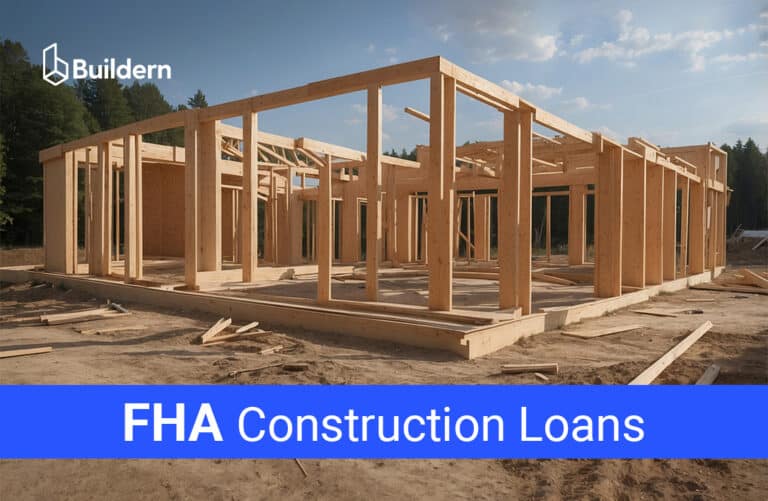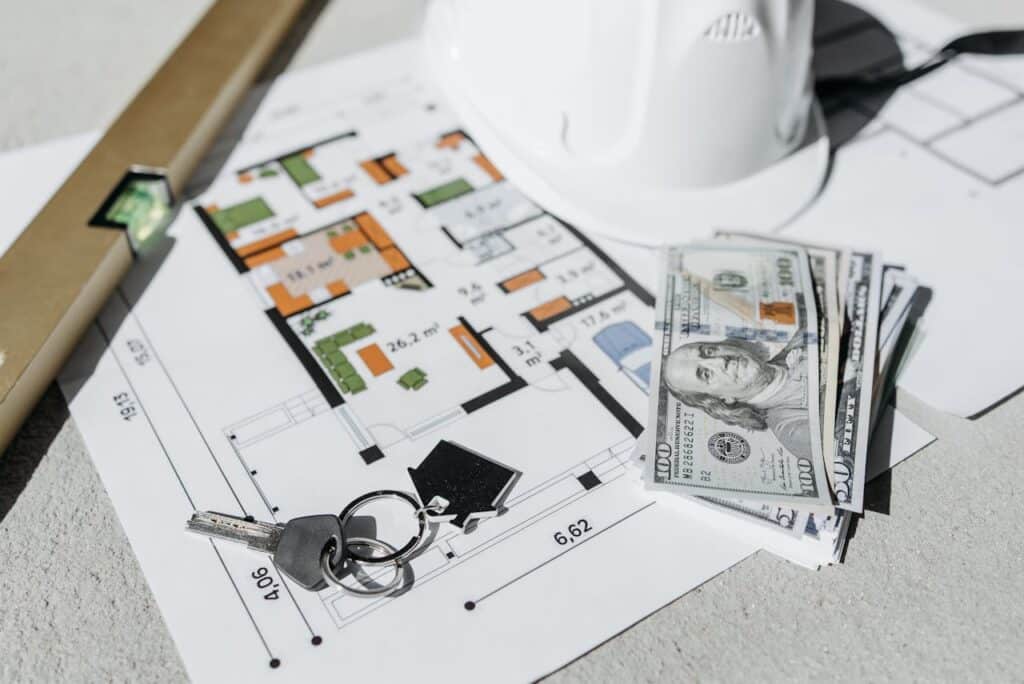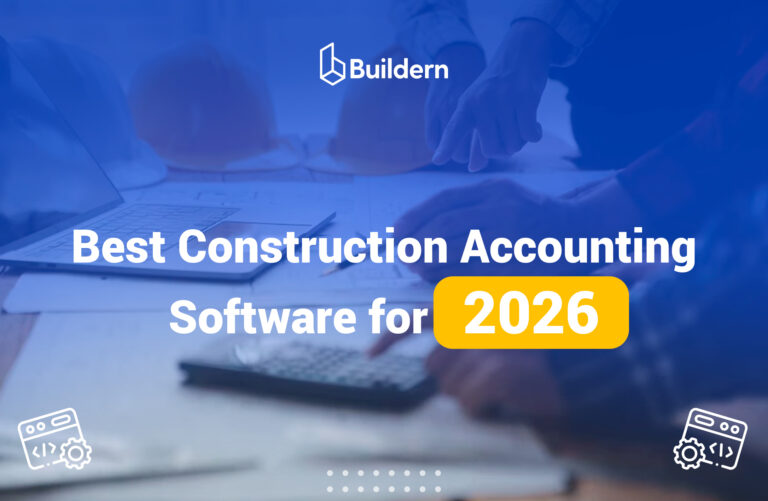FHA Construction Loans: Pros, Cons, Steps, Alternatives, and More

While planning to build a dream from scratch or just remodel the kitchen, financial uncertainty can be a barrier. FHA construction loans might be the solution you’re looking for – but are they the best fit for your construction budget planning?
Understanding all the details before signing up for a 30-plus-year mortgage is crucial for homeowners looking to turn their vision into reality or builders looking to guide their clients through the financial process.
First, let’s break down everything into simple, digestible chunks. My blog article will guide you through the entire start-to-finish process, so you’ll be well-informed about the pros, cons, and all the steps along the way.

Understanding FHA Construction Loans: Pros and Cons
Insured by the Federal Housing Administration (FHA), this type of loan provides short-term financing specifically to cover various construction costs. Once the construction is over, your loan can be rolled into a standard long-term mortgage.
Pros
- Lower FHA construction loan down payment requirements compared to traditional loans. You can receive money for your construction needs with only a 3.5% to 10% down payment.
- Flexible credit score requirements. While most loan types require a minimum of 620 credit scores, FHA loans can be obtained even with 580. In this case, the homeowner receives a subprime loan with a higher interest rate and less favorable terms.
- Flexible debt-to-income ratio. Certain cases may require your DTI to be no more than 43%. However, everything still depends on your credit score and your down payment ability.
Cons
- Minimum property requirements set by the FHA. There are numerous safety and security standards for your new home to abide by, which can result in more time and expense required.
- Additional mortgage insurance premiums. FHA construction loans come with two types of mortgage insurance: an upfront premium due before the construction begins, and an annual premium fee.
- Loan limits vary based on the location, with the FHA setting national limits to accommodate different regional housing costs. In most lower-cost areas, the maximum loan amount available for a single-family home is $472,030. However, in high-cost regions, the loan limit significantly increases, allowing you to potentially secure FHA financing of up to $1,089,300.
Types of FHA Construction Loans

There are two main types to consider when it comes to FHA construction loans:
- Construction-to-permanent loans
- Stand-alone construction loan
Some sources may also state that there is a third loan type for renovation and remodel jobs.
💡You may learn more about home construction loans from our blog:
Let me further go through each type to explain the basics and help you feel more confident when it comes to financing your new home.
Construction-to-Permanent Loans
Also known as a one-time close loan, construction-to-permanent loans provide money for the construction phase of your home, which becomes a traditional mortgage afterward.
Things worth considering:
- A single closing: There’s no need to requalify for permanent financing after the completion of the project since you don’t pay for two separate loans.
- Drawing funds: Loan payments are made by a series of draws to the builder as the construction project progresses.
- Higher interest rates and bigger down payments: These are more costly than other mortgages.
Once the project is over, the construction-to-permanent mortgage becomes a traditional mortgage that can last 15 or 30 years.
Stand-alone Construction Loan
A stand-alone construction loan requires homeowners to get a long-term mortgage once the construction works are complete. This means you will then have 2 sets of closing costs to pay.
Having a standalone loan can result in floating rates and loan terms that can lead to higher interest rates. Some lenders can offer a single closing for certain projects, making the process more streamlined.
Things worth considering:
- You may need a separate loan to pay off the principal amount.
- The amount of money you can borrow may be limited by the FHA, depending on certain criteria like the area and property type.
Top FHA Construction Loan Lenders
As the construction industry continues its growth and adapts to economic changes, getting a construction loan can become rather complex.
New regulatory requirements, market fluctuations, and shifts in lending practices can make everything even more challenging. However, despite this, there are many lenders and financial institutions ready to provide loans for construction projects with comparatively beneficial terms.
We’ve further highlighted some of the top FHA construction loan lenders for the 2025-2026 years, exploring what makes them stand out and how they can assist in making your construction project a reality.
| Lender | Credit Score Requirements | Down Payment Information |
|---|---|---|
| US Bank | 620 | 5% for Conventional Loans, 3.5% for FHA Loans |
| Old National Bank | 620 for Conventional Loans, 500 for FHA Loans | Undisclosed Information |
| New American Funding | 580 for FHA 620 for Conventional Loans | 3.5% |
| Wells Fargo | 620 for Conventional Loans | 3% for Conventional Loans 3.5% for FHA Loans |
Note: The information provided is current as of November 2025. We encourage you to contact these lenders directly, as not all information is disclosed via open sources.
FHA Construction Loan Requirements
Apart from having a high credit score and a solid down payment, there are some additional requirements to consider when applying for an FHA construction loan.
To list a few:
- Have a construction plan: Lenders tend to approve loans for projects that have a detailed construction plan in place. This includes information such as the scope of work, timeline, and budget. That said, builders should provide well-developed construction takeoff plans and estimates.
- Employment Verification: You will need to provide proof of employment and income stability.
- Debt-to-Income Ratio: Your monthly debt payments should not exceed 43% of your gross monthly income (rarely 50%).
- Keep the Limits: Your loan amounts should not exceed the local FHA loan limits.
Meeting these and other unique requirements will help you obtain an FHA loan and minimize your chances of being denied.
How to Apply for an FHA Construction Loan
Working with construction loan providers is quite similar to how you work with banks when applying for a mortgage. You will need to provide the necessary documents and follow the procedure your chosen financial institution offers.
However, as steps can vary depending on your project and local requirements, we will provide you with some general ideas to help guide you through the process:
Step 1. Trust your project to a licensed builder
As obvious as it may sound, it’s essential to work with licensed and reputable builders who have experience in FHA construction loans. They can help you navigate the process and ensure you meet all requirements. Moreover, loan lenders will ask you to provide real and precise construction plans, so they understand your project’s scope and estimated budget.
Step 2. Find an FHA-approved lender
Start by researching and finding lenders in your area that offer FHA construction loans. Compare loan rates and terms for the down payments and the final loan. Once you narrow down your options, choose a lender and start the application process.
Step 3. Sign up for homeowners’ insurance
Most lenders require you to obtain homeowners’ insurance before approving your loan application. You may need to present proof of coverage during the application process, so it’s best to get it in advance.
A reliable insurance package will help you in case of accidents or other events that may occur during the construction process.

Alternatives to FHA Construction Loans
FHA loans are just one of the many methods to finance your home construction project. You may also want to consider alternative solutions, such as:
Conventional construction loans
Typically requiring a higher credit score and down payment, conventional construction loans can include construction-to-permanent and construction-only options. You can either convert your construction loan into a permanent mortgage after the project is complete or have separate loans for each stage of the process.
Home equity line of credit (HELOC)
If you already own another property with equity, you may be able to use a HELOC to finance your construction project. With this option, you can borrow against the equity in your existing home and use those funds for your new construction.
Using HELOC provides overall flexibility to withdraw money as needed through the draw period. As long as you remain within your credit limit, you control the pace and amount of money you access.
Once the draw period concludes, you’ll transition into the repayment phase. The period typically spans a longer term (up to 10 years).
Cash-out refinancing
If you already have an existing mortgage, you can choose to refinance it for additional funds to finance your construction project. It’s also possible in case the loan interest rates go down, and you want to take advantage of that.
With this option, you’ll be replacing your current mortgage with a new one, which includes the money you need for your home construction.
Key Highlights
Now that you have a better understanding of FHA construction loan requirements, you need to carefully evaluate all your options before signing the papers for a 30+ year mortgage.
This commitment will have long-term implications for your financial well-being, so it is essential to seek professional advice and trust the work with reliable home builders. Consider all the costs involved, and choose the option that best suits your needs and budget.
And if you are a construction professional seeking to help your clients with loan options and streamlining your own construction workflows, consider construction management software to manage all the projects and keep track of everything in one place.

Who Offers FHA Construction Loans?
Several lenders across the U.S. provide FHA construction loans. These loans allow borrowers to finance both the construction and the permanent mortgage with a single closing.
Can FHA Loans Be Used for New Construction?
Yes, FHA loans can be used for new construction, but not all types of FHA loans qualify. Borrowers typically use an FHA Construction-to-Permanent Loan (often called an FHA One-Time Close Loan) to finance the building of a new home.
How Much Down Payment is Required for an FHA Construction Loan?
One of the main advantages of FHA construction loans is the lower down payment requirement. You can secure financing with just 3.5% to 10% down, which is significantly less than what traditional construction loans typically require.


